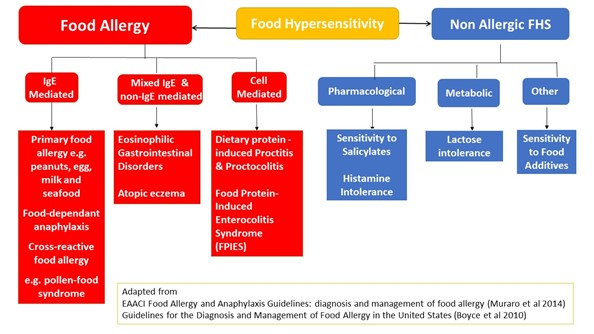Food hypersensitivity is an umbrella term for abnormal reactions to a food affecting an individual. Food allergy is part of the spectrum of food hypersensitivity reactions and includes a variety of different allergic mechanisms.
The most common type of food allergy involves the production of IgE antibodies and so is known as IgE-mediated food allergy. It is an increasingly common condition which affects both children and adults. Most food allergy in children starts in infancy, whereas allergic rhinitis and asthma generally start in later childhood. Food allergy can also start in adult life, with symptoms occurring to foods which have been previously tolerated. The prevalence of food allergy varies with age and geographical location as do the foods, although milk, egg and peanuts are the food triggers most often provoking food allergy in childhood, whereas shellfish and plant foods are frequent food triggers in adults. Diagnosis can often be made from the clinical history and supported by diagnostic tests. Management usually involves the dietary exclusion of trigger foods, but there are now some other options such as immunotherapy. The prevention of IgE-mediated food allergy has been demonstrated to be achievable through early introduction of foods, but more work is needed to confirm this. Non-IgE-mediated food allergy includes FPIES and Eosinophilic Oesophagitis, and management also involves the removal of trigger foods. Non-immune mediated food hypersensitivity includes lactose intolerance, reactions to high histamine foods and also to food additives.

Reactions to foods that are immune-mediated include IgE-mediated, non IgE-mediated, and mixed IgE and non-IgE mediated. Some definitions also include cell-mediated conditions such as coeliac disease. Non-immune mediated conditions included metabolic, pharmacologic, and other reactions including those to food additives.
The reported prevalence of food allergy is consistently greater than challenge-confirmed food allergy. Studies suggest that only 15-20% of children and adults with a stated reaction to food, have a food allergy. The prevalence of confirmed food allergy in UK children has been well studied in 2 birth cohorts on the Isle of Wight; with rates of up to 6% when the children ere aged 4 and under, 3.6% when they were 10 years old and, in one cohort, 4.1% at the age of 18 years. There are no confirmed data for UK adults, although one study found 5.3% of unselected UK adults reported symptoms consistent with a food allergy, compared to 4.4% challenge-confirmed food allergy in European adults.